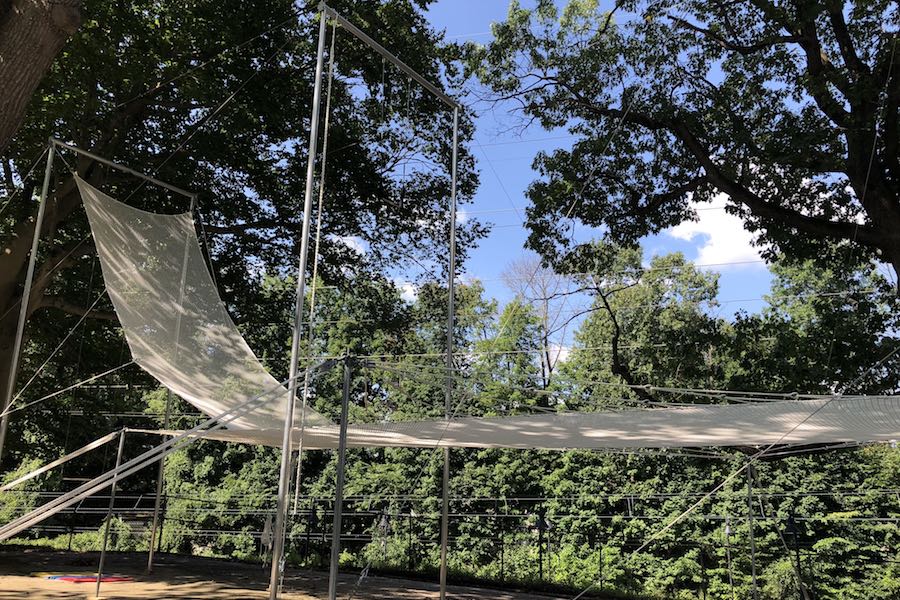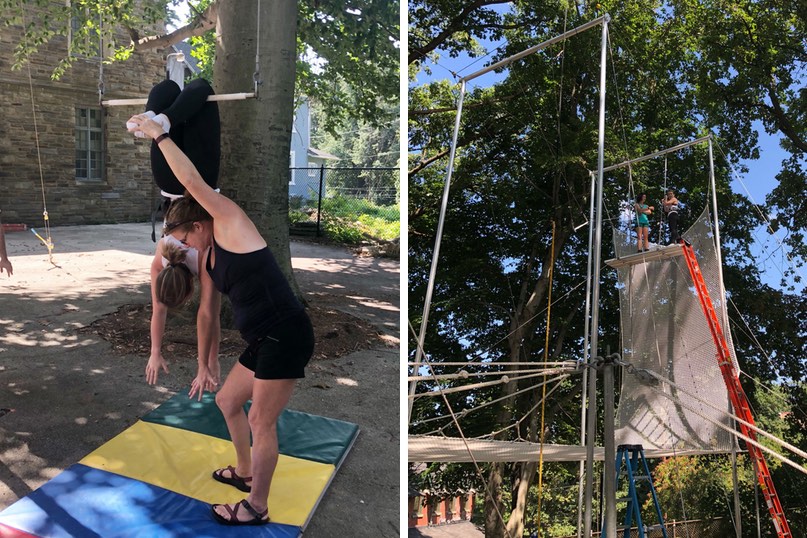Philly’s New Flying Trapeze Is the Scariest Fun You’ll Have This Fall
Looking for an adrenaline rush? Try the Philadelphia School of Circus Arts' new flying trapeze classes.

The new flying trapeze at Philadelphia School of Circus Arts. Photograph by Caroline Cunningham.
The Philadelphia School of Circus Arts (PSCA) has been making quite a few updates since they moved to a much larger building — formerly a church, as a matter of fact — about a year ago. With all the extra space they have, they’ve been able to expand their programming of aerial classes, acrobatics, dance, and more. And now, that programming also includes a flying trapeze.
The flying trapeze — which is set up outdoors on the PSCA’s grounds in Mt. Airy — celebrated a grand opening on August 16. Now through October (the trapeze will be closed through the winter), it’s open for all-levels classes. The classes are two hours long and are offered multiple times a day, Wednesdays through Sundays.
“Since we opened our circus school over 15 years ago, we have always dreamed of having our own flying trapeze rig,” said PSCA executive director Shana Kennedy, in a press release. “Now, with the ample outdoor space we have at Philadelphia’s Circus Campus, Philadelphia Flying Trapeze has become a reality. Anyone in the region can have the experience of flying through the air.”

First, you’ll learn the basics on the ground before moving to the flying trapeze. Photographs by Bailey King.
Eager to check out the new class offering, Be Well Philly stopped by for a weekday class session. By the end of the two hours, we had come to two conclusions about the flying trapeze: 1) It’s completely terrifying and 2) it’s incredibly fun.
Because the classes are open to all-levels, beginners are mixed in with more advanced trapeze artists. At our class, we were divided in half from the beginning — the more seasoned folks started off right on the high-flying trapeze itself, while the rest of us started on a trapeze bar close to the ground, above a cushioned mat.
After getting strapped into the safety belts — which we’d later hook onto cables on the trapeze rigging for security — our instructor talked us through how we’d grab the trapeze bar. Then we practiced hanging from the low bar, swinging our legs, and flipping upside down to hook our knees over the bar.
This all seemed fine. Easy, even.
Then we moved over to the real flying trapeze, where we were told we’d have to climb a bendy ladder all the way up to a tiny platform that’s 23 feet above the ground, grab a bar, and jump off. Um, what?
After watching a couple of the experienced trapeze pros fly through the air like they’d been born with wings, it was the beginners’ turns to try. When I started to climb the ladder, the nerves started to set in about halfway up. By the time I reached the platform, my palms were clammy. Why did I think this was a good idea? I wondered.
As it turns out, the hardest (and by that, I mean scariest) part of flying trapeze is just getting your hands on the bar. Once you make it to the platform, there’s another instructor up there who hooks your belt to cables on either side. Then, they have you stand on the very edge of the platform and lean forward, a hand outstretched to grab the bar, which they drag closer to you with a hook.
Unless you have guts of steel, there’s something in us all that violently protests against leaning over a straight drop, even if there is a safety net beneath you. So when the instructor then tells you to reach out and grab the bar with your second hand, so your arms are outstretched, superman-style, with feet on the platform, hands gripping the bar, your body might just tell you, Nope. Nope. Nope.
But here’s one thing that flying trapeze will quickly teach you: it’s all about that mind-body connection. Nothing about beginner-level flying trapeze is technically difficult or requiring of insane athletic abilities. Because of the simple physics involved, as long as you do what the instructor on the ground tells you to do exactly when she says it, momentum will take over for you.
However, it’s hard to do anything when your body is in full-on panic mode. My first time jumping off the platform, I let out a blood-curdling scream. The instructor was shouting at me to kick my legs, but they’d been replaced with cement blocks. It felt impossible.
By my third and fourth go-around, though, I was no longer convinced I was going to die (despite the fact that one woman did break her littlest toe when she caught it in the safety net). On these turns, I was able to calm my mind, focusing on the basic mechanics of the movements. Only when my mind was settled was my body able to follow directions. And once my body and my brain were on board, that’s when I started really having fun — because, trust me, doing a back flip off a trapeze is fun.
PSCA flying trapeze classes are open to anyone over the age of six and weighing 250 pounds or less. Classes are $63 each, and you can sign up for them here.
Like what you’re reading? Stay in touch with Be Well Philly—here’s how:
- Like Be Well Philly on Facebook
- Follow Be Well Philly on Instagram
- Get the Be Well Philly Newsletter
- Follow Be Well Philly on Twitter


